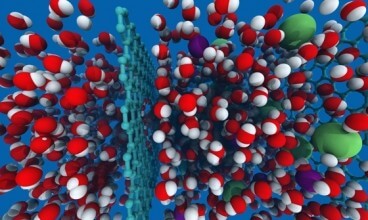MIT researchers evaluate graphene’s potential for making desalination economically viable.
The challenge of dwindling fresh-water supplies looms ever larger as droughts become more common and population increases. To combat this challenge, MIT researchers evaluate the potential for cheaper, smaller, and faster desalination plants in a new study.
“The world has a virtually limitless supply of seawater,” says David Cohen-Tanugi, the lead author of the study and an MIT graduate student in the Department of Materials Science and Engineering (DMSE). “But the process used to filter that seawater is too expensive, and the desalination plants take up valuable oceanside real estate. To make desalination widespread, which is so critical for our future, we need to reduce the cost.”
In the study, released recently in Energy & Environmental Science, Cohen-Tanugi and his coauthors — MIT PhD students Shreya Dave and Ronan McGovern, Professor John Lienhard, director of the Center for Clean Water and Clean Energy at MIT and KFUPM, and Professor Jeffrey Grossman of DMSE — find that if a plant uses a more permeable filter, such as a graphene membrane, to purify water, its energy consumption could be reduced by up to 46 percent. Such improved technology would spur a new generation of desalination plants that are more energy-efficient, as well as smaller and faster.
The study builds on previous work in which Cohen-Tanugi and Grossman modeled the use of sheets of perforated graphene to filter water. Introducing precisely sized nanoscale pores into the material allows water to pass through while blocking salt ions. Because graphene is so much thinner than current polyamide-based filters, water flows through it much more easily — and because it is such a strong material, it can withstand high pressure, which would enable high flow rates. (That research was ranked by Smithsonian as one of the Top 5 Surprising Scientific Milestones of 2012.)
“The thinner your filter, the more water that will go through, and the less energy you will consume in the process,” Cohen-Tanugi says.
Realizing that the new material would yield a far more efficient and possibly less expensive desalination process, the researchers launched the latest study to quantify the potential gains. Their models show that tripling the permeability of the filters used in the desalination plant would allow the plant to use 15 to 46 percent less energy to filter salt and brackish water, respectively. It would also allow for the use of 44 to 63 percent fewer pressure vessels.
“These more permeable filters are more efficient when using brackish water—such as in groundwater—as opposed to seawater,” Cohen-Tanugi says, “so not only will we be able to build smaller plants going forward, we’ll also be able to build them further away from the sea.”
The research was supported in part by the MIT Energy Initiative Seed Fund Program, as well as the NSF Graduate Research Fellowship Program, the Fulbright International Science and Technology Award Program, the International Desalination Association, the Channabasappa Memorial Scholarship, the MIT Martin Family Sustainability Fellowship Program and a generous gift by the Douglas C. Spreng Fund.
If our reporting has informed or inspired you, please consider making a donation. Every contribution, no matter the size, empowers us to continue delivering accurate, engaging, and trustworthy science and medical news. Independent journalism requires time, effort, and resources—your support ensures we can keep uncovering the stories that matter most to you.
Join us in making knowledge accessible and impactful. Thank you for standing with us!

